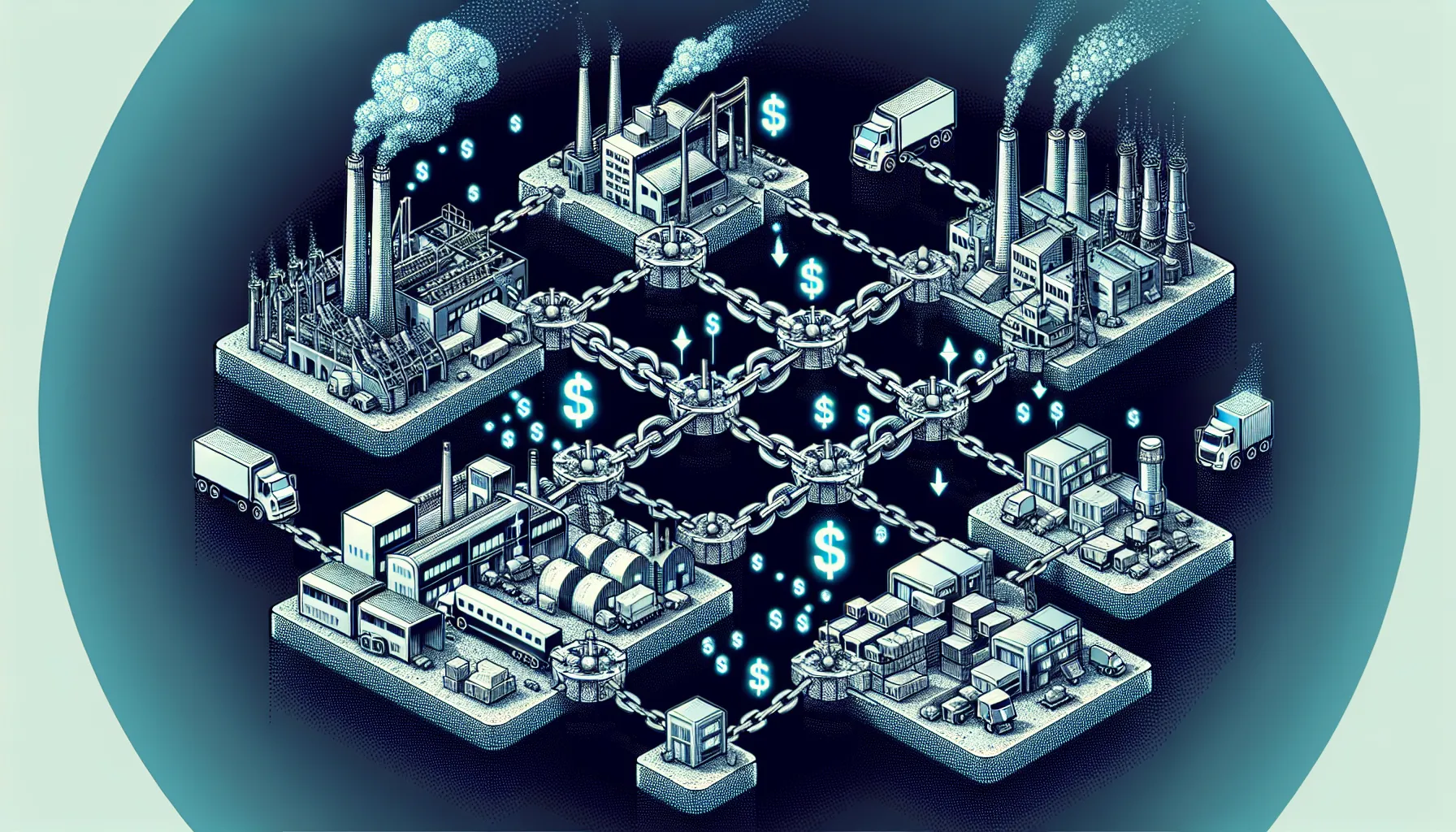Welcome to our IELTS Reading practice test focused on the innovative topic of “Blockchain in reducing supply chain costs”. This test is designed to challenge your reading comprehension skills while introducing you to cutting-edge concepts in supply chain management. As you work through the passages and questions, pay close attention to the vocabulary and structures used, as they reflect the academic language typical of IELTS Reading tests.
Table Of Contents
- Reading Passage 1
- The Promise of Blockchain in Supply Chain Management
- Questions 1-7
- Questions 8-13
- Reading Passage 2
- Blockchain’s Impact on Supply Chain Cost Reduction: A Deeper Dive
- Questions 14-19
- Questions 20-26
- Reading Passage 3
- The Future of Blockchain in Supply Chain Cost Optimization: Opportunities and Challenges
- Questions 27-31
- Questions 32-40
- Answer Key
- Reading Passage 1
- Reading Passage 2
- Reading Passage 3
 Blockchain in supply chain management
Blockchain in supply chain management
Reading Passage 1
The Promise of Blockchain in Supply Chain Management
Blockchain technology, originally developed as the foundation for cryptocurrencies, has found a new and potentially transformative application in the realm of supply chain management. This distributed ledger technology offers a unique combination of transparency, security, and efficiency that could revolutionize how companies track products, reduce costs, and build trust with consumers and partners alike.
At its core, blockchain creates an immutable record of transactions across a network of computers. In a supply chain context, this means that every step of a product’s journey, from raw material sourcing to final delivery, can be recorded and verified without the possibility of tampering. This level of traceability has significant implications for reducing fraud, errors, and delays that often plague traditional supply chains.
One of the most promising aspects of blockchain in supply chain management is its potential to dramatically reduce costs. By eliminating intermediaries and streamlining processes, blockchain can help companies save on administrative and operational expenses. For instance, smart contracts—self-executing contracts with the terms of the agreement directly written into code—can automate many of the manual processes currently required in supply chain transactions, reducing the need for human intervention and the associated costs.
Moreover, blockchain’s ability to provide real-time visibility into the supply chain can help companies optimize their inventory management. With accurate, up-to-the-minute data on stock levels and product movements, businesses can reduce overstocking and understocking, both of which can be costly. This improved inventory accuracy can lead to significant cost savings and improved cash flow.
Another cost-saving benefit of blockchain is its potential to reduce the time and resources spent on dispute resolution. In traditional supply chains, discrepancies in shipments or invoices can lead to time-consuming and expensive disputes between parties. With blockchain, all parties have access to the same unalterable record of transactions, making it easier to identify and resolve issues quickly.
While the implementation of blockchain in supply chain management is still in its early stages, many industry leaders are already exploring its potential. As the technology matures and more use cases are developed, it’s likely that blockchain will become an integral part of supply chain operations, offering unprecedented levels of efficiency, transparency, and cost reduction.
Questions 1-7
Do the following statements agree with the information given in Reading Passage 1? Write
TRUE if the statement agrees with the information
FALSE if the statement contradicts the information
NOT GIVEN if there is no information on this
- Blockchain was initially created for use in supply chain management.
- Blockchain technology allows for the creation of unalterable transaction records.
- Smart contracts require human oversight to execute.
- Blockchain can help companies improve their inventory management.
- Implementing blockchain technology is currently cost-prohibitive for most companies.
- Blockchain can speed up the process of resolving disputes in the supply chain.
- All major companies have already integrated blockchain into their supply chain operations.
Questions 8-13
Complete the sentences below.
Choose NO MORE THAN TWO WORDS from the passage for each answer.
-
Blockchain technology offers a combination of transparency, security, and ____ that could revolutionize supply chain management.
-
In a supply chain context, blockchain can record and verify every step of a product’s ____.
-
By ____ and streamlining processes, blockchain can help companies reduce administrative and operational costs.
-
Blockchain’s ability to provide ____ visibility into the supply chain can help optimize inventory management.
-
Improved inventory accuracy through blockchain can lead to cost savings and improved ____.
-
As blockchain technology ____ and more use cases are developed, it is likely to become an integral part of supply chain operations.
Reading Passage 2
Blockchain’s Impact on Supply Chain Cost Reduction: A Deeper Dive
The integration of blockchain technology into supply chain management represents a paradigm shift in how businesses approach cost reduction and operational efficiency. While the potential benefits are vast, it’s crucial to understand the specific mechanisms through which blockchain can drive down costs and the challenges that must be overcome for widespread adoption.
One of the primary ways blockchain reduces supply chain costs is through enhanced transparency and traceability. In traditional supply chains, the lack of visibility often leads to inefficiencies and added expenses. For instance, when a product is recalled due to a defect, companies often have to recall entire batches or product lines because they can’t pinpoint the exact source of the problem. With blockchain, each component can be tracked from its origin, allowing for targeted recalls that significantly reduce costs and minimize disruption.
Blockchain also facilitates more efficient supplier management and procurement processes. By providing a single, shared version of the truth, blockchain eliminates the need for multiple record-keeping systems and reconciliations between different parties. This not only reduces administrative overhead but also minimizes the potential for errors and disputes. Furthermore, smart contracts can automate many aspects of supplier agreements, from order placement to payment, reducing processing times and associated costs.
Another area where blockchain shows promise is in reducing fraud and counterfeit goods in the supply chain. The pharmaceutical industry, for example, loses billions annually due to counterfeit drugs. Blockchain’s immutable ledger can help verify the authenticity of products at every stage of the supply chain, potentially saving companies enormous sums in lost revenue and liability costs.
Blockchain technology also has the potential to optimize transportation and logistics operations. By providing real-time tracking of shipments and automating customs documentation, blockchain can help reduce delays, demurrage fees, and other costly inefficiencies in the shipping process. Moreover, the technology can facilitate more efficient capacity utilization in transportation networks, potentially leading to significant cost savings.
Despite these potential benefits, the implementation of blockchain in supply chains faces several challenges. The technology requires significant upfront investment and collaboration among multiple stakeholders. There are also concerns about scalability, energy consumption, and integration with existing systems. Additionally, the lack of standardization and regulatory frameworks poses obstacles to widespread adoption.
However, as the technology matures and these challenges are addressed, the cost-saving potential of blockchain in supply chain management is likely to be realized on a larger scale. Companies that successfully navigate the implementation process stand to gain a significant competitive advantage through reduced operational costs, improved efficiency, and enhanced trust with partners and consumers.
Questions 14-19
Choose the correct letter, A, B, C, or D.
-
According to the passage, one of the main ways blockchain reduces supply chain costs is through:
A) Increased production speed
B) Enhanced transparency and traceability
C) Reduced labor costs
D) Improved marketing strategies -
The passage suggests that blockchain can help with product recalls by:
A) Preventing defects in products
B) Allowing for faster shipping of replacement products
C) Enabling more targeted recalls
D) Automatically fixing defective products -
How does blockchain technology improve supplier management?
A) By eliminating the need for suppliers
B) By providing a single, shared record-keeping system
C) By increasing the number of suppliers
D) By slowing down the procurement process -
In the pharmaceutical industry, blockchain could potentially save money by:
A) Reducing the cost of drug development
B) Eliminating the need for quality control
C) Verifying the authenticity of products
D) Increasing drug production speeds -
According to the passage, blockchain can optimize transportation and logistics by:
A) Replacing human workers with automated systems
B) Eliminating the need for customs documentation
C) Providing real-time tracking and automating documentation
D) Reducing the number of shipments needed -
What is mentioned as a challenge to implementing blockchain in supply chains?
A) Lack of potential benefits
B) Too much transparency
C) Overabundance of standardization
D) Significant upfront investment requirements
Questions 20-26
Complete the summary below.
Choose NO MORE THAN TWO WORDS from the passage for each answer.
Blockchain technology offers significant potential for cost reduction in supply chain management through various mechanisms. It enhances (20) ____ and traceability, allowing for more efficient handling of product recalls. The technology also improves (21) ____ and procurement processes by providing a single, shared record-keeping system and automating agreements through smart contracts. In industries like pharmaceuticals, blockchain can help reduce losses from (22) ____ by verifying product authenticity.
In transportation and logistics, blockchain can optimize operations by providing (23) ____ of shipments and automating customs documentation, potentially leading to reduced delays and fees. However, implementing blockchain faces challenges such as the need for significant (24) ____ and collaboration among stakeholders. There are also concerns about scalability, energy consumption, and (25) ____ with existing systems. Despite these challenges, as the technology matures, companies that successfully implement blockchain may gain a (26) ____ through reduced costs and improved efficiency.
Reading Passage 3
The Future of Blockchain in Supply Chain Cost Optimization: Opportunities and Challenges
As blockchain technology continues to evolve, its potential to revolutionize supply chain management and drive significant cost reductions is becoming increasingly apparent. However, the path to widespread adoption and realization of these benefits is complex, requiring careful navigation of both technological and organizational challenges.
One of the most promising avenues for blockchain-driven cost reduction in supply chains is through the optimization of working capital. Traditional supply chains often struggle with inefficiencies in payment processes, leading to tied-up capital and increased financing costs. Blockchain-based solutions, particularly when combined with IoT (Internet of Things) devices and AI (Artificial Intelligence), can enable real-time tracking of goods and automatic triggering of payments upon verified delivery. This not only reduces the need for intermediaries but also significantly speeds up the cash conversion cycle, potentially leading to substantial savings in working capital costs.
Another area where blockchain shows immense promise is in enhancing supply chain resilience and risk management. The COVID-19 pandemic has highlighted the vulnerabilities in global supply chains, with many companies struggling to maintain visibility and control over their extended networks. Blockchain’s distributed ledger can provide a single source of truth for all supply chain participants, enabling real-time visibility into inventory levels, production capacities, and potential disruptions. This enhanced visibility allows for more agile responses to disruptions, potentially saving companies millions in lost revenues and emergency measures.
The integration of blockchain with other emerging technologies presents further opportunities for cost reduction. For instance, the combination of blockchain with 3D printing could revolutionize spare parts management. Instead of maintaining costly inventories of rarely used parts, companies could store digital designs on a blockchain and print parts on-demand, dramatically reducing inventory holding costs and improving service levels.
However, realizing these benefits requires overcoming significant challenges. One of the primary hurdles is the issue of interoperability. For blockchain to truly transform supply chains, it needs to be able to communicate seamlessly with a wide range of existing systems and emerging technologies. Developing standards and protocols for this interoperability is a complex task that requires collaboration across industries and regulatory bodies.
Another critical challenge is scalability. As more transactions are recorded on the blockchain, the size of the ledger grows, potentially leading to slower transaction speeds and increased energy consumption. Various solutions are being developed to address this, including layer-2 scaling solutions and more energy-efficient consensus mechanisms, but their effectiveness in large-scale supply chain applications remains to be fully proven.
The human factor in blockchain adoption cannot be overlooked. Implementing blockchain requires significant changes to existing processes and mindsets. Companies need to invest in training and change management to ensure that employees at all levels understand and can effectively utilize blockchain-based systems. Moreover, there’s a need for new skills in areas such as blockchain development, cryptography, and smart contract programming, which may necessitate significant investments in talent acquisition and development.
Regulatory uncertainty also poses a significant challenge to blockchain adoption in supply chains. The legal status of smart contracts, data privacy concerns, and cross-border regulatory issues are just a few of the areas where clarity is needed. As regulations evolve, companies implementing blockchain solutions need to remain flexible and adaptable.
Despite these challenges, the potential for blockchain to drive substantial cost reductions in supply chains continues to attract investment and innovation. As the technology matures and best practices emerge, we can expect to see more widespread adoption and increasingly sophisticated applications. Companies that successfully navigate these challenges and harness the power of blockchain stand to gain a significant competitive advantage through streamlined operations, reduced costs, and enhanced trust and transparency across their supply networks.
Questions 27-31
Choose the correct letter, A, B, C, or D.
-
According to the passage, how can blockchain optimize working capital in supply chains?
A) By increasing the number of intermediaries
B) By slowing down the cash conversion cycle
C) By enabling real-time tracking and automatic payments
D) By increasing financing costs -
How does blockchain contribute to supply chain resilience?
A) By eliminating all risks in the supply chain
B) By providing real-time visibility into supply chain operations
C) By reducing the number of supply chain participants
D) By slowing down supply chain processes for better control -
What challenge does the passage mention regarding the scalability of blockchain?
A) The inability to record a large number of transactions
B) The potential for slower transaction speeds as the ledger grows
C) The lack of energy required to run blockchain systems
D) The simplicity of blockchain making it unsuitable for complex supply chains -
What is mentioned as a human factor challenge in blockchain adoption?
A) The need for significant changes to existing processes and mindsets
B) The elimination of human jobs in the supply chain
C) The inability of humans to understand blockchain technology
D) The high cost of hiring blockchain experts -
How does the passage characterize the current state of regulations regarding blockchain in supply chains?
A) Regulations are fully developed and clear
B) There is no need for regulations in blockchain implementation
C) Regulatory uncertainty poses a significant challenge
D) Regulations prohibit the use of blockchain in supply chains
Questions 32-40
Complete the summary below.
Choose NO MORE THAN TWO WORDS from the passage for each answer.
Blockchain technology offers significant potential for cost reduction in supply chains, particularly through the optimization of (32) ____. By enabling real-time tracking and automatic payments, blockchain can speed up the (33) ____, leading to substantial savings. The technology also enhances supply chain (34) ____ by providing real-time visibility into operations, allowing for more agile responses to disruptions.
The integration of blockchain with other technologies, such as (35) ____ and AI, presents further opportunities for cost reduction. For example, combining blockchain with 3D printing could revolutionize (36) ____ management, reducing inventory costs.
However, several challenges must be overcome for widespread adoption. (37) ____ is a primary hurdle, requiring the development of standards for seamless communication between systems. (38) ____ is another concern, as growing ledger sizes could lead to slower transaction speeds.
The (39) ____ in blockchain adoption is also significant, requiring investment in training and change management. Additionally, (40) ____ poses challenges, with areas such as the legal status of smart contracts and data privacy needing clarification.
Answer Key
Reading Passage 1
- FALSE
- TRUE
- FALSE
- TRUE
- NOT GIVEN
- TRUE
- FALSE
- efficiency
- journey
- eliminating intermediaries
- real-time
- cash flow
- matures
Reading Passage 2
- B
- C
- B
- C
- C
- D
- transparency
- supplier management
- counterfeit goods
- real-time tracking
- upfront investment
- integration
- competitive advantage
Reading Passage 3
- C
- B
- B
- A
- C
- working capital
- cash conversion cycle
- resilience
- IoT (Internet of Things)
- spare parts
- Interoperability
- Scalability
- human factor
- Regulatory uncertainty
This IELTS Reading practice test on “Blockchain in reducing supply chain costs” covers various aspects of how blockchain technology is transforming supply chain management. It highlights the potential cost savings, efficiency improvements, and challenges associated with implementing blockchain in supply chains. The passages progress from introducing basic concepts to exploring more complex applications and future possibilities, mirroring the increasing difficulty levels typical of IELTS Reading tests.
For more information on related topics, you might find these articles interesting:
- Blockchain in improving transparency in supply chains
- Impact of blockchain on supply chain sustainability
- Blockchain for tracking supply chains
Remember to practice regularly and familiarize yourself with various question types to improve your IELTS Reading skills. Good luck with your IELTS preparation!


